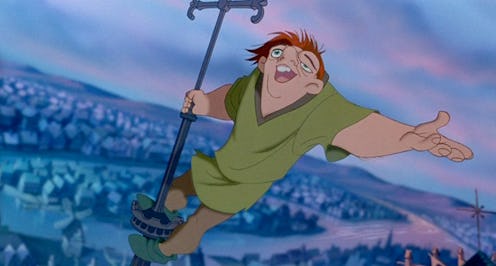
When thinking of the best Disney animated films of the '90s Renaissance era, movies like The Little Mermaid, Aladdin, Beauty and the Beast, and The Lion King come to mind. Disney's 1996 entry into the canon, The Hunchback of Notre Dame, however, has always been treated like the forgotten child of the bunch. Less beloved than its peers but still noted for its stunning animation and music, Hunchback , which turns 20 in June, was under-appreciated at the time because it was different for something audiences would likely be applauding it for today: its acknowledgment of diversity in beauty, and the importance of looking past superficial expectations.
The movie was different for many reasons; based on Victor Hugo's 1831 novel Notre-Dame de Paris, the studio had a lot of hurdles to jump in order to turn such a tragic story into a family-friendly musical film. Set in Paris during the late middle-ages, the novel tells the story of a deformed hunchback named Quasimodo who lives inside the bell tower of Notre Dame Cathedral and serves the villainous Claude Frollo. The book covers themes of racism, classism, religion, and oppression, and the film, for the most part, doesn't shy away from doing the same, making it probably Disney's darkest animated film, albeit one with humorous interludes throughout. Yet for me, it's best remembered as the first time a Disney movie featured a male hero who didn't look like the handsome princes people were so used to seeing.
Hunchback's main character, Quasimodo, was unlike anything Disney movie fans had ever seen before. Here was a main character who, by all modern standards, was considered "unattractive." So used to lovely princesses wooed for their beauty and handsome princes who fall in love at first sight, many moviegoers were taken aback by the presence of a hero that didn't necessarily fit certain standards of beauty. Even critics were worried that kids wouldn't want to see it, considering it wasn't like the Disney films they were used to. "I have no idea how this film is going to fare with the public," said critic Gene Siskel. "The whole notion of softening up Quasimodo's looks...how do you present a character like this for a mass audience?"
In the film, Frollo, responsible for the death of Quasi's Roma Gypsy mother, is disgusted by Quasi's appearance, even as a baby, and decides to dump him into the river. But, guilt-tripped by a priest into taking him in, Frollo instead hides him away in the cathedral, claiming that the world would treat Quasi wickedly and be cruel to him because he doesn't look like the others. So Quasi grows up learning that physical appearances are more important than one's inner beauty, personality, or good deeds. It's a powerful message, one that echoes the ideas formed by many children who grow up bombarded with pressures about how to look and what's considered beautiful.
Frollo is presented as a character who quickly judges based on appearance, and it hugely affects Quasi's sense of self-worth. Whether it's his judgment of Quasimodo, whom Frollo deems so ugly that he deserves to die, or Esmeralda, who is sexualized and deemed exotic, Frollo holds the view that how someone looks is more important than how someone acts. He's deservedly labeled a villain and is criticized for being so judgmental, which is a pretty remarkable thing. Considering how far we've come and are still going in media with body positivity, diverse characters and casting, and the inclusion of disabled actors in various shows, it's clear that Hunchback was a little ahead of its time in its condemnation of judging based on appearances.
And as Quasi faces the world and presents himself as an "ugly" protagonist, viewers learn along the journey that anyone, regardless of how they look, can be a hero. We may not have recognized the movie for it at the time, but now, it's easy to see that Hunchback is a great way to teaboch kids about the acceptance of people who look differently than you, both when it comes to racial differences and the high demands of beauty standards. Everyone deserves to be judged on their actions and words rather than how they look, and the movie reinforces this worthy message.
That's not to say Hunchback's message is perfect; at the end of Hugo's lengthy novel, Esmeralda is hanged, and Quaismodo lies with her in her unmarked grave until he dies of starvation. While no one would really expect a Disney film to go that dark, the movie unwisely goes in the complete opposite direction: Esmeralda lives, as does Quasi, though they don't head off into the sunset together. Esmeralda falls into the arms of the handsome soldier Phoebus, who epitomizes the good-looking male hero we thought we were supposed to be rooting against the entire movie. This conclusion marked the first time that the Disney hero didn't get the girl, and one has to wonder if it's because of how "different" a hero Quasi was from the Disney norm. Perhaps audiences weren't ready to see him find love 20 years ago, but the good news is that today, we certainly are.
Images: Disney, Giphy